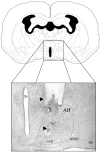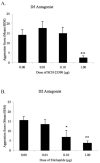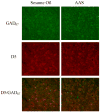Dopamine activity in the lateral anterior hypothalamus modulates AAS-induced aggression through D2 but not D5 receptors
- PMID: 20939664
- PMCID: PMC3131052
- DOI: 10.1037/a0020899
Dopamine activity in the lateral anterior hypothalamus modulates AAS-induced aggression through D2 but not D5 receptors
Abstract
Treatment with anabolic-androgenic steroids (AAS) throughout adolescence facilitates offensive aggression in Syrian hamsters. In the anterior hypothalamus (AH), the dopaminergic neural system undergoes alterations after repeated exposure to AAS, producing elevated aggression. Previously, systemic administration of selective dopamine receptor antagonists has been shown to reduce aggression in various species and animal models. However, these reductions in aggression occur with concomitant alterations in general arousal and mobility. Therefore, to control for these systemic effects, the current studies utilized microinjection techniques to determine the effects of local antagonism of D2 and D5 receptors in the AH on adolescent AAS-induced aggression. Male Syrian hamsters were treated with AAS throughout adolescence and tested for aggression after local infusion of the D2 antagonist eticlopride, or the D5 antagonist SCH-23390, into the AH. Treatment with eticlopride showed dose-dependent suppression of aggressive behavior in the absence of changes in mobility. Conversely, while injection of SCH-23390 suppressed aggressive behavior, these reductions were met with alterations in social interest and locomotor behavior. To elucidate a plausible mechanism for the observed D5 receptor mediation of AAS-induced aggression, brains of AAS and sesame oil-treated animals were processed for double-label immunofluorescence of GAD₆₇ (a marker for GABA production) and D5 receptors in the lateral subdivision of the AH (LAH). Results indicate a sparse distribution of GAD₆₇ neurons colocalized with D5 receptors in the LAH. Together, these results indicate that D5 receptors in the LAH modulate non-GABAergic pathways that indirectly influence aggression control, while D2 receptors have a direct influence on AAS-induced aggression.
(PsycINFO Database Record (c) 2010 APA, all rights reserved).
Figures





Similar articles
-
Dopamine D2 receptors act upstream of AVP in the latero-anterior hypothalamus to modulate adolescent anabolic/androgenic steroid-induced aggression in Syrian hamsters.Behav Neurosci. 2015 Apr;129(2):197-204. doi: 10.1037/bne0000044. Behav Neurosci. 2015. PMID: 25798632 Free PMC article.
-
Anterior hypothalamic dopamine D2 receptors modulate adolescent anabolic/androgenic steroid-induced offensive aggression in the Syrian hamster.Behav Pharmacol. 2010 Jul;21(4):314-22. doi: 10.1097/FBP.0b013e32833b10f1. Behav Pharmacol. 2010. PMID: 20555255
-
Interactions between the dopaminergic and GABAergic neural systems in the lateral anterior hypothalamus of aggressive AAS-treated hamsters.Behav Brain Res. 2009 Oct 12;203(1):15-22. doi: 10.1016/j.bbr.2009.04.007. Epub 2009 Apr 17. Behav Brain Res. 2009. PMID: 19376158
-
Adolescent exposure to anabolic/androgenic steroids and the neurobiology of offensive aggression: a hypothalamic neural model based on findings in pubertal Syrian hamsters.Horm Behav. 2010 Jun;58(1):177-91. doi: 10.1016/j.yhbeh.2009.11.002. Epub 2009 Nov 12. Horm Behav. 2010. PMID: 19914254 Review.
-
Adolescents and androgens, receptors and rewards.Horm Behav. 2008 May;53(5):647-58. doi: 10.1016/j.yhbeh.2008.01.010. Epub 2008 Feb 13. Horm Behav. 2008. PMID: 18343381 Free PMC article. Review.
Cited by
-
A neuroligin-3 mutation implicated in autism causes abnormal aggression and increases repetitive behavior in mice.Mol Autism. 2015 Nov 14;6:62. doi: 10.1186/s13229-015-0055-7. eCollection 2015. Mol Autism. 2015. PMID: 26583067 Free PMC article.
-
The Role of Anabolic Androgenic Steroids in Disruption of the Physiological Function in Discrete Areas of the Central Nervous System.Mol Neurobiol. 2018 Jul;55(7):5548-5556. doi: 10.1007/s12035-017-0774-1. Epub 2017 Oct 2. Mol Neurobiol. 2018. PMID: 28971285 Free PMC article. Review.
-
Anabolic-androgenic steroid use and psychopathology in athletes. A systematic review.Curr Neuropharmacol. 2015 Jan;13(1):101-21. doi: 10.2174/1570159X13666141210222725. Curr Neuropharmacol. 2015. PMID: 26074746 Free PMC article.
-
Dopamine D2 receptors act upstream of AVP in the latero-anterior hypothalamus to modulate adolescent anabolic/androgenic steroid-induced aggression in Syrian hamsters.Behav Neurosci. 2015 Apr;129(2):197-204. doi: 10.1037/bne0000044. Behav Neurosci. 2015. PMID: 25798632 Free PMC article.
-
Mad men, women and steroid cocktails: a review of the impact of sex and other factors on anabolic androgenic steroids effects on affective behaviors.Psychopharmacology (Berl). 2016 Feb;233(4):549-69. doi: 10.1007/s00213-015-4193-6. Epub 2016 Jan 12. Psychopharmacology (Berl). 2016. PMID: 26758282 Free PMC article. Review.
References
-
- Arregui A, Azpiroz A, Brain PF, Simon V. Effects of two selective dopaminergic antagonists on ethologically-assessed encounters in male mice. Gen Pharmacol. 1993;24(2):353–356. - PubMed
-
- Bari AA, Pierce RC. D1-like and D2 dopamine receptor antagonists administered into the shell subregion of the rat nucleus accumbens decrease cocaine, but not food, reinforcement. Neuroscience. 2005;135(3):959–968. - PubMed
-
- Birgner C, Kindlundh-Hogberg AM, Alsio J, Lindblom J, Schioth HB, Bergstrom L. The anabolic androgenic steroid nandrolone decanoate affects mRNA expression of dopaminergic but not serotonergic receptors. Brain Res. 2008;1240:221–228. - PubMed
-
- Bondar NP, Kudryavtseva NN. The effects of the D1 receptor antagonist SCH-23390 on individual and aggressive behavior in male mice with different experience of aggression. Neurosci Behav Physiol. 2005;35(2):221–227. - PubMed
Publication types
MeSH terms
Substances
Grants and funding
LinkOut - more resources
Full Text Sources
Miscellaneous

